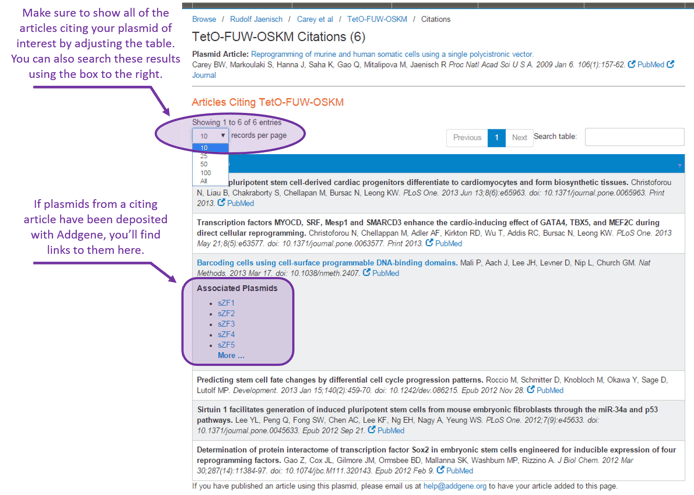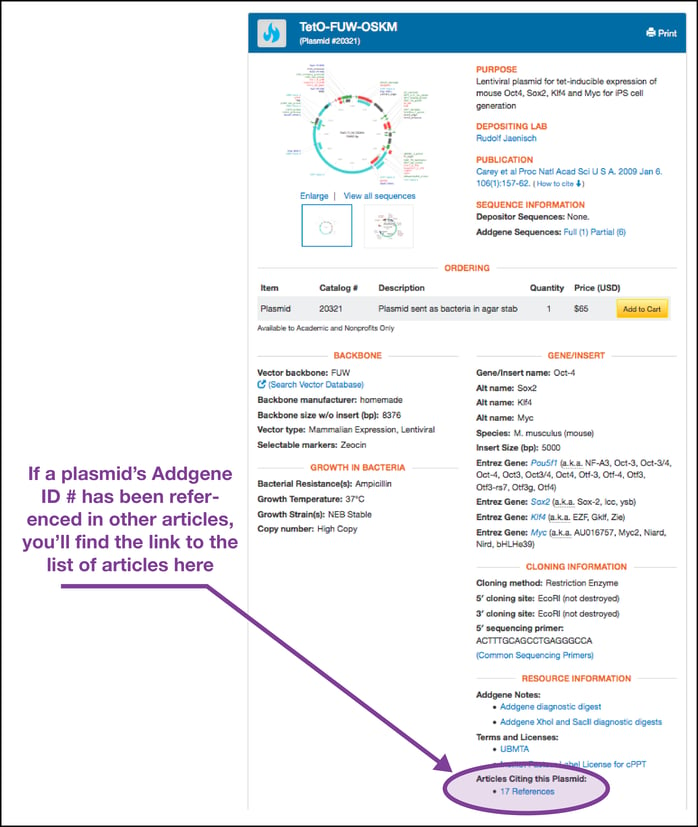Exciting news! Addgene recently rolled out a new feature on our plasmid pages - links to articles citing this plasmid. Now you can learn how a plasmid has been used by multiple labs and see what experimental systems it has been validated in.
If a plasmid's Addgene ID # has been referenced in other publications, you'll find a link to the list of citing articles under the "Resource Information" heading in the right column of the plasmid page. Check out the purple arrow in the screenshot below to see what I mean.
Additional features
Once you've clicked on the "# References" link under the "Resource Information" heading, you'll be directed to a page listing the articles that cite this plasmid. You can use the dropdown to increase the length of the list (purple oval in the screenshot below). You can also use the "Search Table" box at the upper right of the table to search and filter the list of citing articles. From the article list you can click on the PubMed link to find the article abstract and more.
We've also included a feature to help save you from performing any unnecessary cloning - the list of "Associated Plasmids" from these citing articles. What's this? Simply put, if the authors of a "Citing Article" have deposited plasmids associated with this "Citing Article" - such as cloning their gene of interest into a previously deposited vector - then you'll find the plasmids listed below the citation. An example of these "Associated Plasmids" is shown in the purple box below, where the bulleted list of plasmids is associated with the "Barcoding cells using cell-surface programmable DNA-binding domains" publication.

If you want to see this new feature in action, click here to explore the TetO-FUW-OKSM plasmid page. Or search for your favorite plasmids and see where they've been cited.
Benefits to the Addgene community of scientists
Benefits to depositing scientists:
- Access to a list of papers citing your deposited plasmids
- Increased visibility of your plasmids in the "Associated Plasmids" lists
Benefits to requesting scientists:
- Quickly locate other papers that have used your plasmid of interest, which may help you identify relevant protocols and experimental data
- Find other related plasmids in the "Associated Plasmids" lists
- Properly citing plasmids you've requested from Addgene may get your paper listed in the "Articles Citing This Plasmid" list increasing your work's visibility
Help us improve our citations lists
We are still growing our "Articles Citing This Plasmid" database - and we always appreciate any help we can get. If you know of an article that used a plasmid from Addgene, we want to hear about it so we can link to it in the "Articles Citing This Plasmid" list. Email us at help@addgene.org with the Plasmid Name, Addgene Plasmid ID #, and the PubMed ID # (PMID) for the article that has used this plasmid.
Happy researching! If you need any assistance finding plasmids on Addgene's website or would like to contribute plasmids you have made to the repository, email us and we'd be happy to help.
Read More Tips from Addgene
- Plasmids 101: How to Verify Your Plasmid
- Plasmids 101: Control Plasmids
- 6 Tips for Analyzing and Troubleshooting DNA Sequencing Results
- ICYMI: Addgene’s Plasmids 101 eBook
- Protocols and Plasmid References @Addgene
Topics: Addgene News, Using Addgene's Website







Leave a Comment